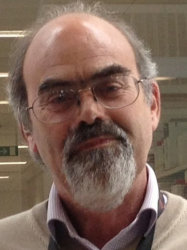Summary
Steven Marston is Emeritus Professor of Cardiovascular Biochemistry
He has been at the National Heart and Lung Institute division of Imperial College London and its predecessors since 1981 (initially at The Cardiothoracic Institute in Beaumont Street, then at Dovehouse Street, when it was renamed NHLI (1991) and subsequently at ICTEM from 2012). His research career has been devoted to investigating the molecular mechanism of muscle contraction and its regulation by Ca2 and phosphorylation.
He obtained a BSc in Biochemistry (1970) and DPhil (1973) at Oxford University, followed by postdoctoral research at the University of Pennsylvania (Prof. A Weber, 1974), University of Chicago (Prof EW Taylor,1976) and in the Zoology department at Oxford University (Dr RT Tregear, 1977). From 1978 to 1981 her was a research scientist at ICI Pharmaceuticals (now part of Astra-Zenica) where he initiated research into vascular smooth regulation and discovered both thick and thin filament linked regulatory proteins.
Muscle systems studied include insect flight muscle (basic mechanisms of force generation and mechano-chemical coupling (1971-1798), vascular smooth muscle (discovery and comprehensive biochemical and structural investigation of the thin filament regulatory protein caldesmon using site-directed mutagenesis: 1981-2008), skeletal muscle (investigation of fundamental mechanisms of congenital myopathies due to actin and tropomyosin mutations: 2002-2015 ) but most importantly, cardiac muscle (since 1998).
He introduced several important experimental techniques to muscle studies at Imperial, including large scale (>10mg) recombinant protein expression (1989) the quantitative in vitro motility assay (1994), the use of PhosTags to measure absolute protein phosphorylation level in situ applied to cTroponinI, MyBP-C and Myosin light chain-2 (2008), measurement of contractility in single myofibrils (2010), the application of molecular dynamics simulations to understanding the modulation of troponin structure and function by phosphorylation and mutants (with Prof Ian Gould, Chemistry Department from 2013) and high throughput measurements of myocyte contractility (2019)
His recent research has concentrated on cardiomyopathies, both acquired heart failure and the genetic myopathies, hypertrophic cardiomyopathy and dilated cardiomyopathy.
His research group investigated mechanisms of regulation at the single filament level by in vitro motility assays and also in more organised systems including human heart muscle and transgenic mouse models of cardiomyopathies. This approach recognizes the fact that animal models alone are often inadequate representations of human disease whilst investigation on human tissue has practical limitations and the state of tissue examined may not be physiological. By applying a common range of experimental techniques to both animal and human heart resolution of these problems becomes more likely.
His achievements in this area include
- Demonstration of reduced protein phosphorylation and increased Ca2 -sensitivity as a common outcome of end-stage heart failure in human heart muscle
- Demonstration of increased Ca2 -sensitivity as the primary molecular abnormality in hypertrophic cardiomyopathy due to mutations in thin filament proteins
- Demonstration of MyBP-C haploinsufficiency as a fundamental molecular mechanism in HCM caused by MyBP-C mutations.
- Demonstration that mutations in skeletal muscle actin and tropomyosin in biopsies from patients with a hypercontractile phenotype cause a gain of function and elucidation of the molecular mechanism of this.
- Investigating the fundamental mechanism of DCM-associated mutations in human tissue samples and in recombinant protein and transgenic mouse models. Demonstration that the common abnormality in thin filament mutations (and several other genes) was the absence of a Ca2 -sensitivity shift when troponin I is phosphorylated by PKA (uncoupling)
- Demonstration that uncoupling is sufficient to induce symptoms of heart failure under chronic stress
- Discovering titin truncation mutations in human heart muscle with familial dilated cardiomyopathy and investigation of the contractile abnormality responsible for the disease phenotype by measurements in isolated human myofibrils.
- Discovery of small molecules that can reverse uncoupling and thus are potential treatments for inherited cardiomyopathies. Investigation of the function of these small molecules in vitro, in silico and in myocytes and muscle
Professor Marston is a past member of the Editorial Board of Biochemical Journal and International Journal of Biochemistry
He is currently an Editor of Journal of Muscle Research and Cell motility, Chair of the Imperial /London Muscle Initiative and British rep on the Council of European Society for Muscle Research
Publications
Journals
Luther PK, Marston SB, 2024, Complex architecture of cardiac muscle thick filaments revealed, Trends in Pharmacological Sciences, Vol:45, ISSN:0165-6147, Pages:191-192
Yang Z, Marston SB, Gould IR, 2023, Modulation of Structure and Dynamics of Cardiac Troponin by Phosphorylation and Mutations Revealed by Molecular Dynamics Simulations, Journal of Physical Chemistry B, Vol:127, ISSN:1520-6106, Pages:8736-8748
Marston S, 2023, Recent studies of the molecular mechanism of lusitropy due to phosphorylation of cardiac troponin I by protein kinase A, Journal of Muscle Research and Cell Motility, Vol:44, ISSN:0142-4319, Pages:201-208
Marston S, Pinto J, 2023, Suppression of lusitropy as a disease mechanism in cardiomyopathies, Frontiers in Cardiovascular Medicine, Vol:9, ISSN:2297-055X, Pages:1-12
Pavadai E, Rynkiewicz MJ, Yang Z, et al., 2022, Modulation of cardiac thin filament structure by phosphorylated troponin-I analyzed by protein-protein docking and molecular dynamics simulation., Archives of Biochemistry and Biophysics, Vol:725, ISSN:0003-9861, Pages:109282-109282

